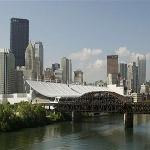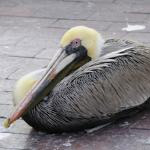
BOB DOUGHTY: This is SCIENCE IN THE NEWS, in VOA Special English. I'm Bob Doughty.
FAITH LAPIDUS: And I'm Faith Lapidus. This week, we will tell about the medical condition known as atrial fibrillation. We also will tell about two studies of seabirds, and how a change of color could help fight rising temperatures. And, we will tell what officials in California have done to protect historic objects on the moon.
(MUSIC)
BOB DOUGHTY: Atrial fibrillation produces an abnormal heartbeat. People feel their heart race and they lose their breath. The problem may last a few seconds, but it can get worse and worse with age, leading to a heart attack or stroke.
Doctors generally treat atrial fibrillation with drugs. But a recent study shows that another treatment may have better results for patients who were not helped by drugs. The treatment is called catheter ablation. Doctors place a long thin tube called a catheter into the heart. Then they use radio frequency energy to heat the tissue around the catheter. The heat burns off a small amount of heart muscle. The goal is to block abnormal electrical activity in the heart.
FAITH LAPIDUS: Researchers studied more than 150 patients whose condition had failed to improve after taking at least one drug. In the study, about 100 of the patients had catheter ablation. The others were treated with more drugs. There was a nine-month follow-up period to compare the effectiveness.
David Wilber of Loyola University Medical Center in Illinois was the lead writer of a report about the study. He says catheter ablation worked in 60 to 70 percent of the patients. By comparison, abnormal heartbeats returned in 80 to 90 percent of those treated with drugs.
Doctor Wilber says catheter ablation is not meant to be the first treatment choice for atrial fibrillation. He suggests it only when drug therapy fails to work. The report appeared in the Journal of the American Medical Association.
(MUSIC)
BOB DOUGHTY: A report in the journal Current Biology says fish and other food thrown from boats can influence the movement of birds. A team of scientists used satellite information about a fishing area near the Mediterranean coast of Spain. Satellite images followed the travels of two kinds of seabirds: the Cory's shearwaters and the Balearic shearwaters. The team learned that the birds traveled one way on days when fishing was permitted, and another way when it was not.
The scientists kept detailed records of the birds' travel over a number of flights. The trips lasted an average of about two days. Some birds flew ten kilometers during that time. But others traveled up to 1,000 kilometers. The birds traveled longer distances when they did not see fishing boats. The birds spread out from one another to do this, and they spread with increasing speed.
FAITH LAPIDUS: The lead scientist was Frederic Bartumeus of the Center for Advanced Studies of Blanes in Spain. He calls the actions of the seabirds, a superdiffusive process. The process let them look effectively for small hake and other fish that move often and unpredictably. But when the birds saw fishing boats, they looked for food near the boats. That reduced their spreading action and slowed their speed.
Professor Bartemeus says the study shows how human activities in the natural environment can change the travels of other organisms. The scientists say their findings may help the study of invasive species.

BOB DOUGHTY: In another study, some brown pelicans on the west coast of the United States have been acting mysteriously. About 20,000 brown pelicans fly south from the American state of Oregon each winter. Experts say the birds usually have flown to southern California or Mexico by this time of year. But, during the past three years, some have failed to fly south. Uncounted numbers of pelicans have remained in Oregon.
Many are thought to have died of cold or hunger or in severe storms. Wildlife rescuers in Oregon say some of the birds have been seen around restaurants and cafes. Even when people are present, the birds reportedly eat food that has been thrown away. And, people have been seen feeding them.
Experts say pelicans usually fear human beings. They urge people to leave the birds alone.
(MUSIC)
FAITH LAPIDUS: Large cities are known to have higher temperatures than rural areas in summer months. This extra heat can raise temperatures in cities by about one to three degrees Celsius compared to rural areas.
Scientists say there are many reasons for this. One reason is that heat from the sun can go through many of the building materials commonly found in cities. One such material is asphalt, a substance often placed on top of buildings and used to cover road surfaces.
BOB DOUGHTY: Recently, American researchers studied ways to reduce the heat in developed areas. Scientists with the National Center for Atmospheric Research led the study. They found that painting the tops of buildings white could possibly help to cool cities and slow the effects of climate change.
The researchers used a computer model that predicted the effects of the sun's heat. They compared the effects of black surfaces on rooftops with white roofs. They found that a city with only white rooftops could reduce the urban heat effect by 33 percent.
FAITH LAPIDUS: However, white roofs could have the opposite effect in winter. That is because they have a cooling effect within buildings. Cooler building temperatures in the winter could require more energy to heat the buildings.
The researchers found that some cities would be helped more than others from white roofs. This would depend on the total surface area of roofs in a city. It would also depend on the building materials used since some materials are less resistant to heat than others. The researchers say white roofs would work best in areas with warm climates and strong sunlight all year.
The team's findings were published in the Geophysical Research Letters. America's National Science Foundation paid for the study.
BOB DOUGHTY: Scientists say more information is needed before they can be sure that painting roofs white would help battle rising temperatures. Keith Oleson was the lead writer of the report. He says the study shows that, in theory, white roofs could be effective in reducing urban heat. However, he says, it remains to be seen if it is possible for cities to paint their roofs white.
(MUSIC)
FAITH LAPIDUS: Finally, the state of California is far away from the moon. But California officials recently registered objects left by the first men to land on the moon's surface. The state's historical resources agency recognized the more than 100 objects as historically protected.
California has a deep interest in the objects. Many state-based companies helped develop machines and equipment that made the moon landing possible.
BOB DOUGHTY: Americans Neil Armstrong and Edwin "Buzz" Aldrin landed on the moon on July 20th, 1969. The two astronauts explored an area that they called "Tranquility Base." Lack of space in their lunar spacecraft, the Eagle, forced them to leave equipment on the surface.
The lower half of the spacecraft, or landing vehicle, still lies there today. So do empty food containers, space boots, life support systems and an American flag. They were just a few of the things the astronauts left behind. The total weight of equipment remaining on the lunar surface is about 2,268 kilograms.
FAITH LAPIDUS: Some scientists support the idea of historical protection for the remaining objects. They hope that someday Tranquility Base will be named a United Nations World Heritage Site. But the current California action registers only the objects, not Tranquility Base. International law bars any nation or state from claiming lunar surfaces.
Beth O'Leary is a professor at New Mexico State University. Miz O'Leary is a supporter of honoring space heritage. She expresses concern that people traveling in space might someday damage the spaceflight objects.
At the moment, however, that threat does not seem immediate. A budget proposal by President Obama cancels the American space agency's plans for manned spaceflights to a lunar station. At least for a while, historic objects on the moon remain far away and safe from human hands.
(MUSIC)
BOB DOUGHTY: This SCIENCE IN THE NEWS was written by Jerilyn Watson, Caty Weaver and Brianna Blake, who was also our producer. I'm Bob Doughty.
FAITH LAPIDUS: And I'm Faith Lapidus. Join us again next week for more news about science in Special English on the Voice of America.
atrial fibrillation: fibrillation of the muscles of the atria of the heart 心房纤维性颤动
catheter ablation: an invasive procedure used to remove a faulty electrical pathway from the hearts of those who are prone to developing cardiac arrhythmias 心导管消融术
shearwaters: long-winged oceanic bird that in flight skims close to the waves 鹱
superdiffusive: of or pertaining to superdiffusion 超级扩散的
hake: a large sea fish that is used for food 无须鳕(海产鱼,可食用)
pelican: a large waterbird with a bag of skin under its long beak, for storing food 鹈鹕
asphalt: a thick black sticky substance used especially for making the surface of roads 沥青;柏油
Science of safety: how seat belts, Kevlar arrived
In consumer electronics, 3-D and all things wireless
How Earth is cracked like a giant eggshell
Time -- one of the great mysteries of our universe
(来源:VOA 编辑:陈丹妮)
